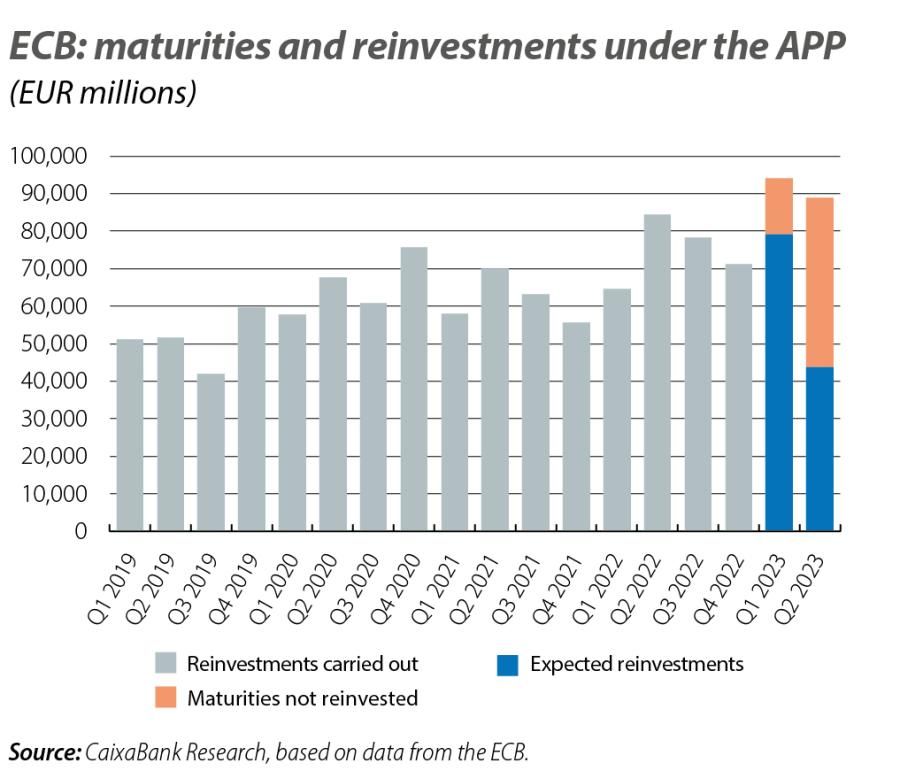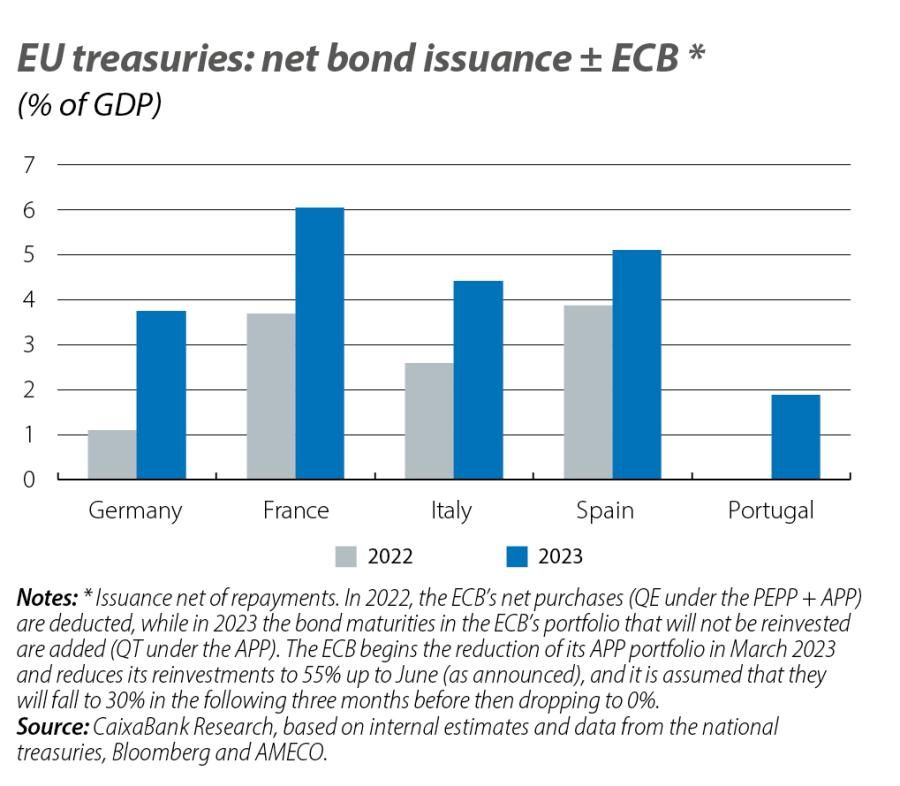The reduction of the ECB’s balance sheet in 2023
This year, the ECB will not only continue to raise interest rates, but it will also reduce the size of its balance sheet. How will this reduction work and what consequences could it have for sovereign debt?

The ECB’s balance sheet reached almost 70% of euro area GDP in mid-2022, a substantial increase from its usual size before it began large-scale purchases of long-term assets and loans (e.g. 20% at the end of 2014). With these unconventional measures, the euro area has lived for years in an environment of ultra low interest rates. That was until 2022 arrived and the ECB raised its official rates by 250 bps between July and December. In 2023, not only will these rate hikes continue, but the ECB will also reduce the size of its balance sheet. How will this reduction work and what consequences could it have for sovereign debt?
By the end of 2022, the ECB’s balance sheet had already reduced in size by around 10% due to various early repayments of TLTRO-III loans,1 after their conditions were modified in October 2022. The portfolio of TLTRO-III loans will continue to wind down in 2023, both due to new early repayments and simply due to them reaching maturity. In addition, there will be a reduction in the portfolio of bonds acquired since 2015 under the asset purchase programme (APP). The APP represents almost 40% of the ECB’s balance sheet2 and the majority (80%) of these assets consist of sovereign debt bonds of euro area countries. Although the ECB ceased net purchases in July 2022, so far the stock of the assets held on the balance sheet has remained stable due to reinvestments: when a bond held by the central bank matures, the central bank uses the payments received to purchase new bonds and keep the size of its portfolio constant. However, on 15 December the ECB announced the beginning of the end of these reinvestments: between March and June 2023 the ECB will allow bonds worth 15 billion euros (monthly average) to expire without reinvesting them, meaning that it will reduce the reinvestments by around 50% (see first chart).
- 1. TLTROs (Targeted Longer-Term Refinancing Operations) are long-term loans granted by the ECB to the banking sector.
- 2. The other major purchasing programme, the PEPP (Pandemic Emergency Purchase Programme), was launched during the pandemic and accounts for 20% of the balance sheet. In total, under the PEPP and the APP, sovereign bonds held by the Eurosystem rose to 4.2 trillion euros by the end of 2022.

Beyond June 2023, the ECB will adjust this 15-billion benchmark and, in a context of monetary tightening, the threshold can be expected to be raised until the reinvestments reach zero. This, coupled with further repayments of TLTRO-III loans, could reduce the ECB’s balance sheet by 15% during the course of 2023. This would bring it down to 50% of the euro area’s GDP, which is still above pre-pandemic levels (see second chart).3
- 3. This projection assumes that the ECB reduces reinvestments under the APP to 30% in Q3 2023 and to 0% in Q4 2023. This explains 20% of the projected reduction in the size of the balance sheet. As for the TLTRO-III loans, which account for the remaining 80%, the projected reduction only contemplates the repayment of all the loans that will fall due in 2023 (the majority).

The expansion of the balance sheet turned the ECB into a major player in the bond market and, moreover, this trend was accompanied by lower interest rates. Thus, its reduction in 2023 leads us to ask what impact it might have on sovereign funding needs and on interest rates.
Using the above projection regarding the balance sheet as a starting point, we can compare sovereign funding needs between 2022 and 2023. The key difference between these two years is that in 2022 the ECB was still carrying out net purchases under the APP and PEPP, so it was absorbing both gross funding needs (with reinvestments) and net funding needs. In 2023, in contrast, not only will the ECB no longer be carrying out net purchases, but by reducing the reinvestments it will also no longer be covering a portion of the issues that are carried out to make repayments. As shown in the third chart, with the ECB’s withdrawal from the market, more issues of treasury bonds will need to be placed with other agents.4 The impact of this is by no means negligible, but the figures ought to be manageable. For example, net funding needs in the Spanish market stand at 5% of GDP; this is above the average for 2015-2019 (–1.3%, at a time when the ECB was actively buying up debt and the deficit was not so high) but it is below the average needs for the period 2008-2014 (6.9%). In addition, it should be borne in mind that in 2023 the ECB will remain very much present in the markets through its reinvestments under the PEPP. Furthermore, national treasuries have a good track record of placing issuances in recent years, in a period that in a period that has not exactly been free of volatility.
- 4. Unlike in the other countries, the heightened stress in Germany and France is accentuated by increases in the budget deficit.

In turn, the increase in debt placement needs can generate some pressure on market interest rates. To quantify this pressure, we use our macro – or fair value – interest rate model.5 The idea behind these models is that the interest rate on public debt depends on the macroeconomic fundamentals of the country in question and on the global economic environment. For instance, a country’s ability to service its payments depends on its level of indebtedness, expectations about its public surplus or deficit, and the future growth of the economy. Also, the state of the European economy as a whole determines the monetary policy that is set by the ECB, which it uses to influence the myriad of other interest rates. With these ingredients, and on the basis of the historical relationships between them, we can estimate what sovereign interest rate would be consistent with the macroeconomic fundamentals.6 ,7 This «macro rate» allows us to study the sensitivity of interest rates to changes in the economic scenario, such as a deterioration in the growth outlook or, as in the present case, a reduction in sovereign debt held by the Eurosystem. According to this exercise, the end of reinvestments under the APP ought to apply contained pressure on sovereign interest rates in 2023, in both the core andthe peripheral economies.
Thus, overall the analysis suggests that in 2023 the reduction of the ECB’s balance sheet will accompany, rather than intensify, the tightening of monetary conditions triggered by the official rate hikes. While the experience of other institutions, such as the US Fed, shows that episodes of volatility can occur in the markets when central banks withdraw,8 it also makes it clear that the monetary authorities have tools at their disposal to restore the proper functioning of the markets if necessary.
- 5. See the Focus «The macroeconomic fragility of interest rates» in the MR10/2020.
- 6. We estimate individual regressions for the 10-year sovereign rates of Germany, Austria, Belgium, Spain, France, Ireland, Italy, the Netherlands and Portugal with the following explanatory variables: 3-month Euribor expectations, real GDP growth and inflation expectations, the government-debt-to-GDP ratio, an indicator of stock market volatility, the US 10-year sovereign rate, the asset purchases which the ECB has accumulated on its balance sheet since 2015 and an indicator of stress in the euro area (a binary variable which is equal to 1 if a sovereign risk premium is significantly stressed).
- 7. The estimated impact is partial. i.e. it considers the direct effect of a reduction in the volume of bonds held by the ECB, but not the indirect effect which this may have on global financial conditions or on the outlook for GDP and inflation, nor does it contemplate indirect effects of TLTRO-III repayments.
- 8. See the case of the US repo market in September 2019. Anbil, Sriya, Alyssa Anderson and Zeynep Senyuz (2020). «What Happened in Money Markets in September 2019?». FEDS Notes. Washington: Board of Governors of the Federal Reserve System.
